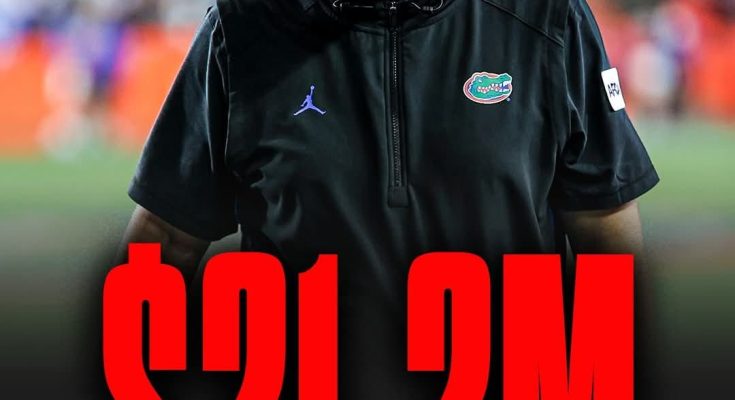Napier was hired by Florida in late 2021 (ahead of the 2022 season) after a strong run at University of Louisiana at Lafayette where he compiled a 40‑12 record over four seasons. (SI) His hire at Florida came with a 7‑year contract worth roughly $51.8 million in guaranteed compensation (base salary plus certain benefits). Under the contract, his base salary for the 2025 season was $7.4 million, and the salary included annual escalators (about $100,000/year in the deal) as noted by multiple reports.
The contract also contained language: if Napier were fired without cause (or the school terminated him), Florida would owe him 85 % of his remaining annual compensation. () Moreover, his contract reportedly included a no‑mitigation clause (meaning that if he took another coaching job, Florida could not offset what they owed against his new salary).
Here’s how the buy‑out math shakes out: because his remaining guaranteed compensation through January 2029 was substantial (given the 7‑year length and the annual escalators), UF faced a buy‑out figure of approximately $21.2 million (some sources approximate around “just over $21 million” or around $21.0 m) when the decision was made to fire him following the 2025 season start. Under the structure of his contract, about 50 % (so roughly $10.6 million) was due within 30 days of termination; the remainder was to be paid in equal annual installments (approximately $2.65 million each year for the next four years) from July 15 of the subsequent years, until fully paid. In sum: Florida is still obligated to pay Billy Napier around $21 million even though he has been relieved of his duties.
The timeline: Napier’s tenure at Florida ended in October 2025, after a 3‑4 start to the season (including losses to lower‑profile in‑state rival South Florida Bulls), and although his final game was a narrow 23‑21 win over Mississippi State Bulldogs, the administration opted to move on. The decision was prompted by unmet expectations: Florida had entered the 2025 season ranked No. 15 in the preseason polls, but the results under Napier did not align with the historical standards of the program. (SI) So, despite the victory, his record at Florida (22‑23 overall, 12‑16 in SEC play) and particularly his record against ranked opponents and away games (5‑17 vs. ranked, 0‑14 away) weighed heavily. With that context, Florida announced the dismissal and named longtime receivers coach Billy Gonzales as interim head coach. (Reuters)
So what are the implications? First, paying such a large buy‑out is a non‑trivial financial burden for any athletic department, even one as well‑resourced as Florida’s. While $21 million isn’t unprecedented in major‑college football coaching circles, it is still substantial. For instance, some other major programs have even higher buy‑outs, but the size of the payout matters. Florida will continue paying this while concurrently hiring a new coach and carrying other overhead (including the prior coach’s remaining payments in other cases). So the financial strain, or opportunity cost, is real. Second, from a program perspective: the decision signals that Florida’s leadership has concluded Napier was not the long‑term solution, despite the resources given to him (recruiting, facilities, NIL climate, etc.). They’re effectively acknowledging that the return on investment was insufficient. Third, for Napier himself: receiving this buy‑out gives him both a financial cushion and a level of leverage in his next job search. Because his contract’s no‑mitigation clause means that if he lands another head coaching position, he gets paid that salary on top of the buy‑out from Florida. That makes his next next move financially favorable. Fourth, for the broader college‑football coaching market, this is yet another example of the risk institutions take when hiring big‑ticket coaches: long contracts, escalating salaries, and generous exit terms increase the stakes if things don’t go as planned.
A few observational notes: when Napier was hired, Florida believed they were making a forward‑looking hire: a youngish, successful Sun Belt coach who could restore the Gators toward elite status. He had done well at Louisiana, and Florida likely thought he could replicate that in the SEC. But the jump from successful mid‑major to elite SEC power is fraught with difficulty. In Napier’s time at Florida, after a reasonably promising 2024 season (culminating in a four‑game win streak to close the year), the 2025 campaign began poorly, and the fan base grew restless. (SI) The timing of his firing — just after a win — suggests that Florida’s evaluation was not merely about the current game but about trajectory, momentum, and simply the expectation of winning at a higher level.
From the perspective of Florida, they must now manage multiple pieces: the financial obligation to Napier, the process of hiring a new coach (and likely offering a competitive contract), the ongoing payments to the previous coach (depending on how their alignment works), and maintaining recruiting, team morale, and program stability during the transition. When programs pay large buy‑outs, there’s always the risk of “two head coach problem” — paying both the outgoing coach and new coach simultaneously — which can hamper resources. In Napier’s case, it is explicitly noted that the buy‑out is broken into installments which helps somewhat, but the first installment is due within 30 days, so there’s immediate cash impact. (CBS Sports) Also, the optics for boosters and fans matter: big payouts can create frustration if they believe the decision was avoidable, or that the hiring process was flawed in the first place.
On the flip side, for Napier, he leaves Gainesville with a significant financial guarantee. The fact he was released despite a win underscores how high the expectations were at Florida: wins alone weren’t enough; dominance, or at least consistent ascendancy, was required. Given the no‑mitigation clause, his future salary earnings won’t offset what Florida owes him — meaning he is in a strong negotiating position for his next move. Many in the coaching industry may view this as a “good problem to have” for him, financially speaking.
Finally, there’s a cautionary tale here for college football programs: when you guarantee large sums in coaching contracts and build in generous exit terms, you are risking fiscal and programmatic disruption if things don’t go the way you hope. Conversely, coaches entering such deals in the modern era know they are in a strong bargaining position. The alignment of expectations, resources, institutional culture, and on‑field performance has to match; if not, the institution pays — literally and figuratively — the price.
In summary: Florida has owed Billy Napier around $21 million following his dismissal, with roughly half due within 30 days and the rest spread over the following years. The size of the buy‑out, the no‑mitigation clause, his record, Florida’s expectations, and the fiscal ramifications all combine to make this a noteworthy episode in modern college football coaching and institutional strategy. If you like, I can pull up a detailed breakdown of how this compares with other major buy‑outs in college football (e.g., at other SEC schools or national powers) so you can see how Florida’s obligation sits in the bigger landscape.



